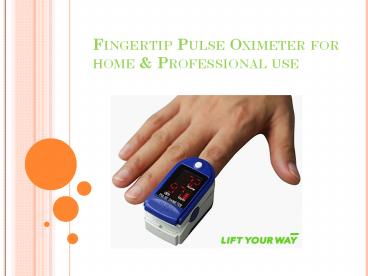Fingertip Pulse Oximeter for home & Professional use
Title:
Fingertip Pulse Oximeter for home & Professional use
Description:
.Buy Fingertip pulse oximeter online at liftyourway.com . Great prices for quality Product.Order Now!!! – PowerPoint PPT presentation
Number of Views:32
Title: Fingertip Pulse Oximeter for home & Professional use
1
Fingertip Pulse Oximeter for home Professional
use
2
Pulse Oximeter - What is it?
A meter used to measure the concentration of
oxygen in the blood.
It is done with an oximeter, a photoelectric
device specially designed for this purpose and a
reusable probe.
The oximeter works on the principle that the
oxygenated blood is a brighter color of red than
the deoxygenated blood, which is more blue-purple.
3
Pulse oximeters display oxygen saturation, pulse
rate, pulse strength, low battery, and alarms.
There may be a waveform display also.
Invented in 1972 by Takuo Aoyagi, an electrical
engineer at Nihon Kohden company in Tokyo.
4
What Does it Do?
5
Pulse Oximetry provides estimates of arterial
oxyhemoglobin saturation (SAO2) by utilizing
selected wavelengths of light to
noninvasivelydetermine the saturation of
oxyhemoglobin
6
- Handheld Pulse Oximeter
7
Why is it used?
it is used to detect hypoxia. hypoxia is a
pathological condition in which the body as a
whole (generalized hypoxia) or a region of the
body (tissue hyoxia) is deprived of adequate
oxygen supply.
8
Areas of Use
- Anesthesia standards require pulse oximetry on
all anesthetized patients. - Used with ventilator dependant patients.
- Frequently incorporated into vital signs monitors
measuring heart rate, blood pressure, and
temperature. - It is commonly used in the hospital in the
continuous mode for critical applications and
intermittently for less critical patients.
9
Benefits of Use
- Low cost (Finger units lt50).
- Ease of Use (Clip and Press).
- Degree of Accuracy.
10
Limitations of Use
- Intravenous Dyes.
- Motion.
- Low Perfusion states.
- Black or blue nail polish.
11
Areas of concern
- Sensitive to motion.
- Readings below 85 have increased error.
- Low perfusion state increases error.
- Ambient light interferes with reading.
- Delay in reading of about 12 seconds.
- Dysfunctional hemoglobin.
12
Since first generation devices, technical
advances which have been made to improve pulse
oximetry include
- Calibration resistors and chips embedded into the
sensor. - The use of ECG synchronization techniques.
- Various motion sensing improvements.
- Specialty sensors for high altitude climbers.
- Smart alarm systems for pulse oximeters.
- A reduction in size, cost and power use.
- Wireless connection via Bluetooth technology.
13
Pulse oximeters are relatively safe devices with
a few safety issues
- Infection especially with reusable sensors.
- Possible heating and minor burns to sensitive
skin due to the red/infra-red LEDs. - Routine electrical safety concerns.
14
(No Transcript)































